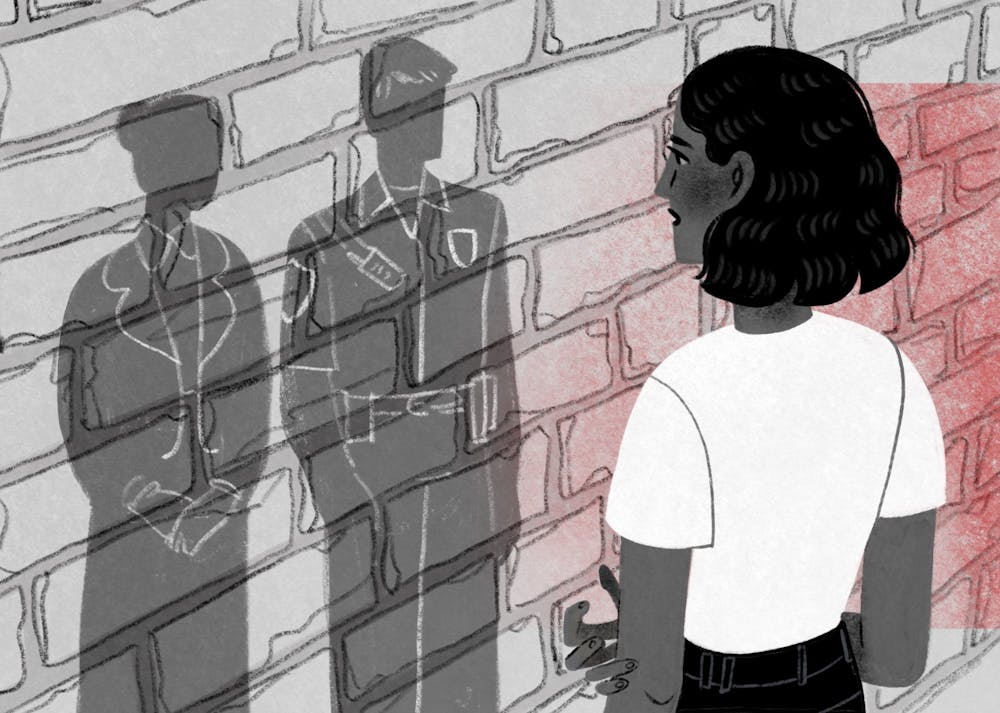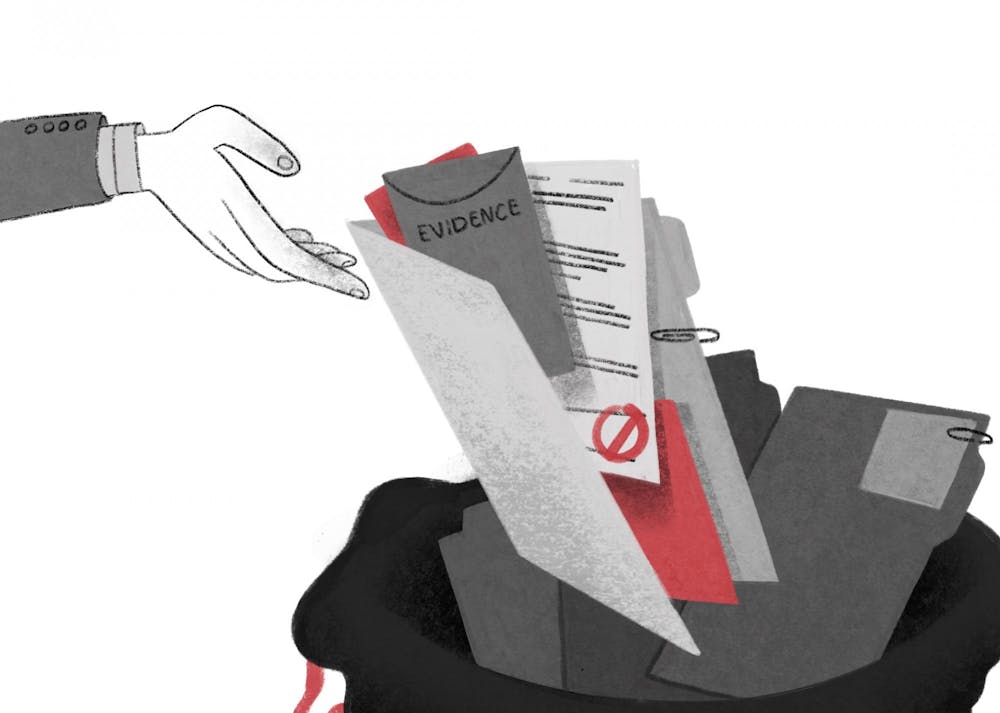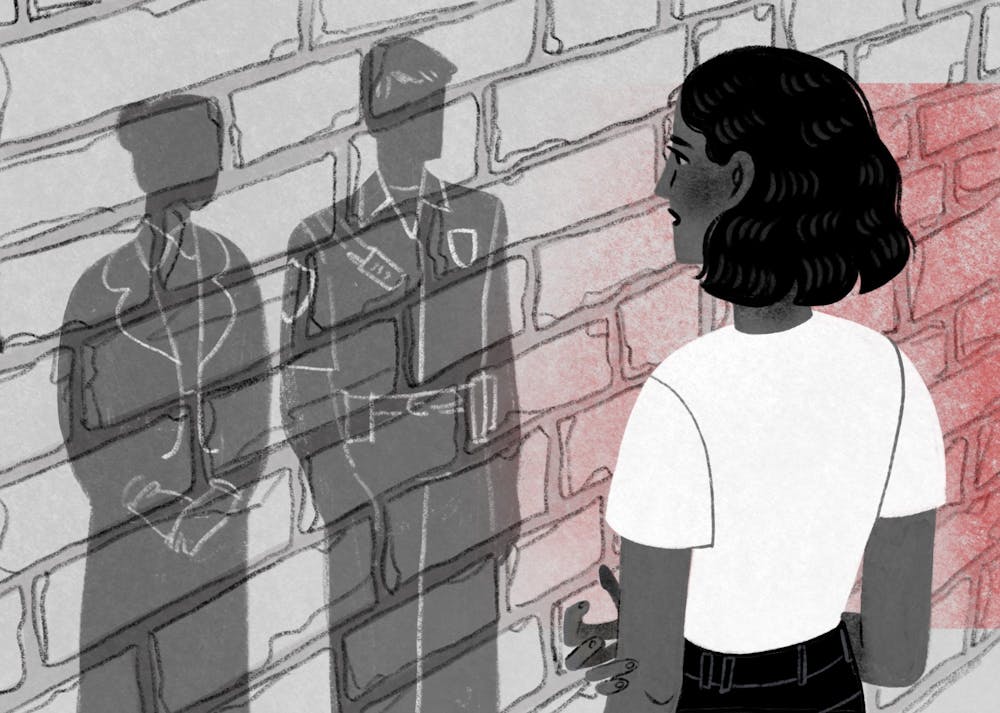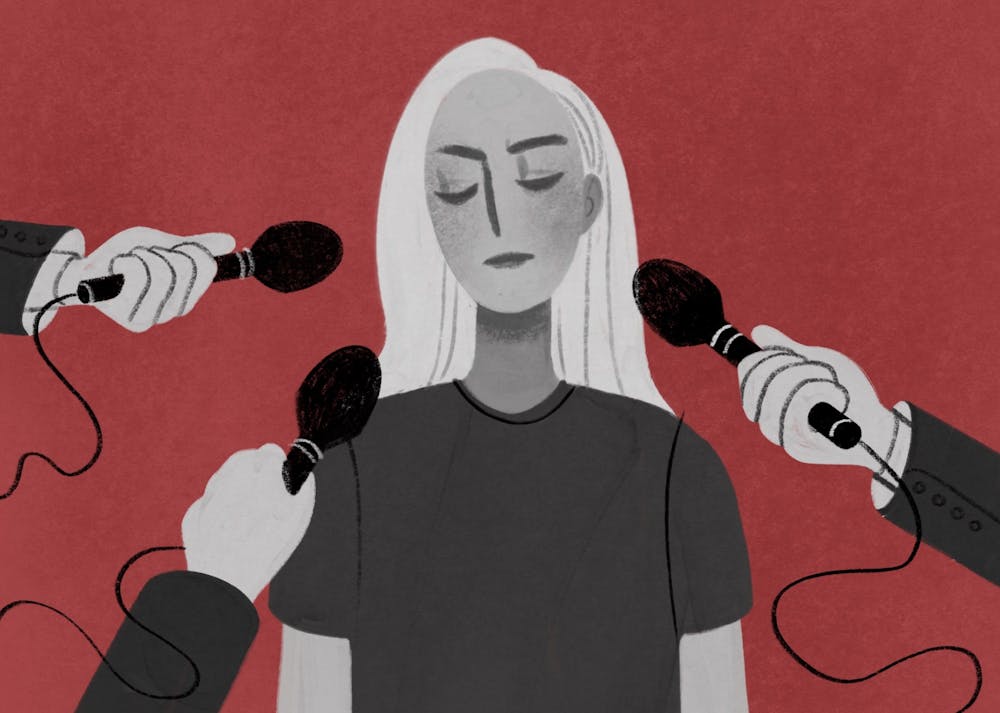Content warning: This article contains mentions of sexual assault and other sensitive issues. For additional resources, contact the national sexual assault hotline at 800-656-4673 or visit the Rape, Abuse & Incest National Network's website.
After seeking support from Sun Devils Against Sexual Assault, a support and advocacy group that is not affiliated with the University, Alayna decided to go public with her story about her on-campus rape and reporting experience to hold both her assailant and the University accountable.
Alayna's story spurred support for a years-long endeavor from students and organizations to protect sexual assault survivors on ASU's campuses. Alayna's last name is being omitted to protect her privacy.
“I read so many cases about girls getting raped at ASU and it made me feel worse, like a lot worse, because there was no justice. Nothing ever happened,” said Alayna, a former communications major. “And I didn’t want to be another one of those.”
Rape is the most common violent crime at ASU, UA and NAU. From 2017 to 2019, 68 incidents of rape were reported at ASU, according to the University’s Annual Security and Fire Safety Report.
The 68 incidents of rape recorded at ASU reflect an increase of 14 compared to the preceding three-year period. Records show not a single case from 2017 to 2019 investigated by ASU PD was prosecuted at the county level.
Data show that ASU PD clears, or definitively closes, rape cases at a lower rate than the national average. A spokesperson for ASU PD said sexual assault investigations are naturally complicated.
But advocates and an ASU criminology professor cite ASU PD’s controversial policies and poor treatment of victims as reasoning for the lack of prosecution.
Jasmine Lester, a 2011 ASU graduate and founding director of SDASA, said Alayna’s case “is not an isolated incident.”
“This is systemic at all colleges, across universities, including ASU,” Lester said. “Rape culture is not going to go away overnight.”
Since Alayna posted a series of videos about her assault on Instagram, other survivors have reached out and shared their experiences.
“I personally don’t feel any better hearing ‘me too,’” from other sexual assault survivors, Alayna said. “It sucks actually, knowing someone else went through it.”
Less than half of reported sexual assaults led to University punishment since 2014
When reporting sexual assaults to ASU, there are four options: report to ASU PD or a local department, Student Rights and Responsibilities, the Office of University Rights and Responsibilities or through a Title IX complaint.
Leah Henthorne, a junior studying interior design, said she was sexually assaulted during her freshman year at ASU. Once she told her mom a few months after the incident, they looked online for ways to report and the possible outcomes of each. She thought about reporting anonymously but felt like it wouldn’t go anywhere and instead reported her assault to the University, disclosing her name.
Henthorne said there was “a lot of fear and worry about the whole situation” because “I knew I was going to come face-to-face with all the trauma from the assault and having to say it over and over again like a broken record.”
According to data provided by the University, 277 instances of sexual assault have been reported to the University since 2014. Of those, 147 led to investigations and 101 led to notices informing the alleged assaulter an investigation through SRR was taking place.
Even if all 101 notices were found to have had a violation, that would mean less than half of reported sexual assaults led to University punishment.
In the 2019 to 2020 academic year, SRR found 36 of 55 sexual misconduct cases, roughly 65%, led to notices and were found to be violations of the Student Code of Conduct, according to a University spokesperson. Data show only four of the found violations could have been a sexual assault case.
Sexual misconduct cases include domestic violence, stalking, sexual harassment and sexual discrimination, the spokesperson said. University spokespeople could not provide a further breakdown of how many sexual assault investigations, like Alayna’s and others, found the Student Code of Conduct had been violated, despite having 10 business days to do so.
Both criminal and University investigations require evidence to produce a decision on punishment, but Joanne Vogel, vice president of student services, said fewer standards need to be met for the University to determine if there was a potential violation of the Student Code of Conduct compared to the criminal process.
An investigation with SRR into alleged assault involves students and typically takes four, sometimes simultaneous, steps: disclosure, support, reporting and follow-up, Vogel said.
Disclosure, Vogel said, means the University is made aware of an incident. Next is providing the victim support through ASU Counseling Services or victim advocates who work with the student throughout the process and grant accommodations as needed. All support services are confidential, Vogel said.
“The administration told us the ASU PD victim advocates are sufficient because they don’t feel overwhelmed,” Lester said. “And to me, that just shows they aren’t being utilized and that students and victims don’t trust them.”
An SRR investigation will involve one of 12 investigators who is trained annually, said Kendra Hunter, assistant vice president for student services and dean of students at ASU West who also oversees SRR investigations. Vogel said investigators typically start with a victim interview and then other witnesses.
Having investigations and support occurring simultaneously “can be really overwhelming,” Henthorne said, describing a feeling of being “bombarded” by people asking questions even if they were just trying to help.
ASU PD cleared rape cases below national average in eight of past 10 years
From 2017 to 2019, 46 of the 68 cases were investigated by ASU PD, and the remaining 22 cases were investigated by SRR, URR or through the Title IX complaint.
SRR tracks data using academic years while ASU PD and the Maricopa County Attorney’s Office both use calendar years.
When the University and ASU PD investigate cases of sexual assault, the two work together to share information and ensure there is no overlap, Vogel said.
The investigations are separate, said Katie Paquet, a University spokesperson. Although they may share information, there are “different potential outcomes” for each.
Henthorne first reported to SRR, but after three months with no decision, she rereported to ASU PD. About a month later, ASU PD made an arrest, but the charges were dropped. Six months after she originally reported her assault, SRR did not discipline her assailant either, Henthorne said.
Even after the investigation, Henthorne's assailant was still in her classes, she said.
“When the University just doesn’t do anything, (it feels like) you don’t have the full support of your school and that’s just so wrong,” Henthorne said. “They just take everything from you.”
A case is considered cleared when it has been definitively closed, whether because it has concluded in arrest or for any other circumstance. For instance, a case would be considered cleared if allegations are found to be fabricated or insufficient, according to an ASU PD spokesperson.
Data provided by an ASU PD spokesperson shows the department historically clears a smaller percentage of rape cases than the national average, which typically ranges between 32%-41%, according to FBI Uniform Crime Report data.
In the last decade, ASU PD only exceeded the national average in 2011 and 2018. ASU PD did not provide clearance data for 2013, when the FBI was in the process of changing its definition of rape.
Every other year, ASU PD trailed the national average by anywhere from 13% to 41%, according to UCR data.
ASU PD did not clear any rape cases in 2009 and 2010, though there were only four rape investigations conducted during these two years, according to data provided by the department.
From 2017 to 2019, ASU PD had a county prosecutor referral rate of 26% according to data provided by an ASU PD spokesperson, six times higher than the RAINN national average rate of 4%.
Vogel said conclusions of a police investigation typically do not impact the University because ASU PD operates on a quicker timetable of around 60 to 90 days.
“I would have a meeting and wait a few weeks for an update. I would hear nothing from them then I would have another meeting, wait another few weeks,” Henthorne, who reported her case to both SRR and ASU PD, said. “And then at one point, it was just silent. I’d heard nothing from them in probably two months.”
Though there may not be enough evidence for a criminal investigation to move forward, there may be enough for SRR to determine there was a violation of the code of conduct.
Accounts of the assault are often very different between the victim and alleged assaulter, Hunter said. Eyewitnesses, text messages and videos can all be “good evidence” that could corroborate a story and “help determine what was more likely than not to occur.”
In any investigation conducted by the University, an investigator will share a final report with the dean of students involved, who will then make a decision based on facts and evidence, Vogel said.
“My interpretation oftentimes is that going through that process of having someone challenge your statements, test them out and focus on the facts and the truth, does not feel warming,” Vogel said. “And it can feel very much like you're being discredited and you're not being believed.”
Both Alayna and Henthorne found the questioning step in the process confusing and felt they were not given enough information by ASU.
Investigators try to limit the number of interviews, but “as more facts or evidence are presented, we oftentimes have to follow up with complainants, respondents and witnesses,” Vogel said. ASU PD will also conduct multiple interviews if needed, a spokesperson said.
In Alayna’s case, officers contacted her at least six times during the 70-day investigation and questioned her at least four times, according to the police report. This repeated contact and questioning triggered trauma for Alayna.
Vogel said the investigation process is where the University receives the most complaints because victims do not feel supported in the process.
“You can be a very good listener, and you can be empathetic, but at the same time remember we've asked these investigators to be neutral, impartial, fact-finding — we've given them a very difficult challenge” of remaining neutral and not showing personality, she said.
The University works to ensure students are aware of what the investigation will look like, but sometimes, victims do not fully realize what will happen until they are there, Vogel said.
“I feel like they stretch out the investigations and they put you through this brutal process,” Henthorne said. “The aftermath sometimes is more painful than the assault because you're reliving it over and over again.”
Often, victims report feeling judged by ASU PD officers during the investigations, said Lester, founding director of SDASA. “They re-traumatize victims and they make the investigative process as awful as possible.”
Conducting multiple interviews with the victim is not considered best practice, said Cassia Spohn, a professor at ASU’s School of Criminology and Criminal Justice and member of a Department of Defense advisory board on sexual assault in the military. Sexual assault is a traumatic event, and victims often cannot recall every detail perfectly, she said.
“To expect the victim of a violent crime to tell a coherent story, from point A to point B to C to D, and so on, in a logical way, that's just not how memory works,” Spohn said “It's not how people respond to traumatic events.”
ASU PD said its officers receive training on how to best communicate with victims of traumatic events and to be more empathetic, a department spokesperson said.
Across the county, it’s common for detectives to compare details from each interview and use inconsistencies to question a victim’s credibility, Spohn said, calling it a practice that puts “victims in a real no-win situation” and can have a serious impact on the outcome of a case.
“If the police officer is overtly distrusting of what the victim is telling him or her, then that could certainly dissuade the victim from continuing to cooperate,” Spohn said. “I think a lot of a victim’s lack of cooperation does stem from signals that officers send either overtly or subtly.”
Since 2017, no ASU PD sexual assault cases were prosecuted by MCAO
ASU PD referred 11 rape cases to the Maricopa County Attorney’s Office for prosecution between 2017 and 2019, according to data from the county attorney’s website. Another four cases, all from incidents in 2019, have been referred so far this year, according to MCAO Custodian of Records Debbie MacKenzie.
All cases referred to MCAO by ASU PD between 2017 and 2019 were refused – prosecutors either declined to file charges or sent the case back for further investigation. So far in 2020, two cases have been refused while two others await a decision, MacKenzie said.
In general, investigators must prove sexual acts occurred and were not consensual in order to establish probable cause for arrest.
In eight police reports detailing sexual assault in 2019, obtained by The State Press through an open records request, only two involving students ended in referral to MCAO. Four cases cited a victim's failure to cooperate as the reason for its closing.
A March 16, 2019, case was sent to MCAO after ASU PD obtained two confessions and corroborated evidence. Using a one-party consent call, ASU PD asked the victim to call the assaulter, confirm their identity and ask for an apology, without disclosing that an officer was with the victim. According to the police report, the assaulter said “I’m sorry that in my drunkenness that I ended up raping you.” The assaulter confessed again during arrest.
In another case reported on Oct. 17, 2019, the police report cited text messages where the victim stated they did not want to have sex prior to the incident as “enough evidence” to make an arrest. The assailant admitted to having sex with the victim.
In an emailed statement, MCAO’s Communications Director Jennifer Liewer wrote, “every case submitted to this office is reviewed independently and the facts and evidence of each case is considered.”
She said the office only files charges in cases if there is, “a reasonable likelihood of conviction at trial.”
Spohn said prosecutors need to consider more than just evidence. Even if it points to assault, the victim’s credibility and level of cooperation may impact a jury's decision. Spohn said prosecutors must consider whether a jury may believe the myth that “good girls can’t be raped.”
The process is not something she agrees with, calling prosecutor and detective mindsets like this “cynical,” Spohn said.
“The prosecutor is looking downstream to the jury or to the judge,” Spohn said. “What would the jury or what would the judge do in this case? How would they see the victim and her behavior at the time and after the incident? And how will these things get twisted and interpreted?”
According to the police report, Alayna’s case was closed because she declined to let ASU PD extract data from her phone which they defined as “a key piece of evidence.” It also cited discrepancies, such as what she said she was wearing leaving the scene of the assault.
Proving sexual acts occurred without consent often comes down to he-said-she-said accounts, the ASU PD spokesperson said.
Spohn and victim advocates said the investigation process, not the complexity or difficulty of the crime itself, makes it challenging for victims to receive any form of justice.
Spohn said one of the many myths of sexual assault cases and the one she thinks is “the most dangerous” is the idea of a “real rape” is committed by a “stranger who jumps out of the bushes and holds a knife to her throat or a gun to her head.
“We know that those cases are rare and that is not a typical sexual assault, but in the minds of many jurors, that is what counts as sexual assault.”
Process frustrates survivors, leaves them without closure
Neither ASU PD’s nor SRR’s investigations led anywhere for Alayna or Henthorne.
“I’m also not interested in reopening my case at all,” Alayna said. “They had many opportunities to do the right thing and they chose not to.”
To understand and process what had happened, Alayna created a half-hour long video explaining her story. Since, she has heard from other survivors who used similar methods to cope.
“A lot of people who reach out to me are not willing to ever fight with ASU, which angers me,” Alayna said. “It’s nice to hear you’re not alone, but also I feel like if I were to ever fight with the school again, it would be a lot more powerful with people supporting me.”
Lindsay Krause, a sophomore nursing student, has been friends with Alayna for almost a year. To help lift some of the emotional weight from Alayna’s shoulders, Krause created a website that links to an SDASA petition and drafts an email reiterating the organization's demands for a rape crisis center and more to University President Michael Crow. Krause said more than 560 people had used the link she created, but she’s not sure how many people have sent the email.
“I don’t even really know what to say. It’s awful,” Krause said. “I feel like the school really makes you feel like they’re there for you and that they will investigate … and you do everything you’re supposed to and it feels like they do everything in their power to make it hard.”
While there may not be an all-encompassing solution to handling reports of sexual assault, ASU students and graduates have been fighting to establish resources to help others like Lester, who said she’s been working with groups like the Multicultural Solidarity Coalition for about three years to push the University to create a rape crisis center.
Lester, who has helped dozens of victims navigate the reporting process, said one of the gaps in ASU’s response to sexual assault is the lack of on-campus forensic exams, which includes rape kits.
A rape kit is performed by a doctor or nurse and is used to preserve evidence of sexual assault. During the exam, health care professionals ask victims about their medical history, collect clothing items, document and treat bruises and cuts and collect saliva, blood, urine, skin, hair and other samples.
While DNA evidence can be collected within 72 hours, rape kits should be performed sooner rather than later because showering, using the restroom or changing clothes can damage evidence, according to RAINN's website.
Students in need of a rape kit exam must seek one from a medical center off-campus, according to the ASU PD spokesperson, who said the exam can still be done in a timely fashion despite having to leave campus.
Spohn said police departments should be careful not to downplay the importance of rape kits.
“To argue that it's really not necessary to do an exam unless the victim and suspect are strangers is really pretty short-sighted,” Spohn said.
ASU PD said rape kits indicate if intercourse occurred and that signs of a struggle are missing because sexual acts among college students begin consensually and escalate to rape, the spokesperson said. The spokesperson said, “then it's up to us to determine if it was consensual or not.”
Demands for a rape crisis center, more on-campus victims advocates
University spokespeople said ASU already has all of the services a rape crisis center would provide at various health and student services locations.
Alayna said forming a rape crisis center could give students a place to learn about their legal rights and get help from someone who is not directly connected to ASU.
Lester said “advocates that are dedicated to intimate partner violence and sexual violence and trained to do that and do that full-time,” may change someone’s reporting experience exponentially.
Henthorne said she’d like to see a rape crisis center on campus as well as improved sexual assault classes, an expedited investigation process, specialized psychologists in ASU Counseling Services and easier access to self-defense classes.
“I’m making it my goal to keep fighting for change,” Henthorne said. “To make sure the school doesn’t leave anyone else broken into a million pieces because no one deserves to go through this.”
SDASA and student coalitions have released statements advocating for the establishment of a rape crisis center and a meeting with ASU administrators. Their demands include employment of nine full-time confidential victim advocates not part of ASU PD, reimbursement for Alayna’s legal and specialized therapy fees.
A University spokesperson said Educational Outreach and Student Services will have a meeting to discuss the matter, but exact details are still being determined.
SRR follows and will always follow Student Code of Conduct and Title IX procedures to ensure due process for all parties, Hunter said. Procedures in sexual assault investigations will stay the same until there is change from the U.S. Department of Education or the Arizona Board of Regents.
Accountability from University officials and resources created to ensure no student has to go through a process that complicates an already traumatic experience is the only outcome Alayna would like to see after posting her experience publicly.
Treating sexual assault cases at universities like the “serious violent crimes” they are, could be a better way to help solve cases, Spohn said.
“There is not a typical sexual assault, and I don't think that there should be a typical sexual assault response,” she said. “I don't think that there is a magic solution.”
Reach the reporters at pjhanse1@asu.edu, wmyskow@asu.edu and atonoder@asu.edu or follow @piperjhansen, @wmyskow and @AndrewOnodera on Twitter.
Like The State Press on Facebook and follow @statepress on Twitter.

Wyatt Myskow is the project manager at The State Press, where he oversees enterprise stories for the publication. He also works at The Arizona Republic, where he covers the cities of Peoria and Surprise.

Andrew Onodera oversees the day-to-day needs of the State Press multimedia department as managing editor. He is also an intern at KPNX-12News and previously worked at the Howard Center for Investigative Journalism.

Piper Hansen is the digital editor-in-chief at The State Press, overseeing all digital content. Joining SP in Spring 2020, she has covered student government, housing and COVID-19. She has previously written about state politics for The Arizona Republic and the Arizona Capitol Times and covers social justice for Cronkite News.







